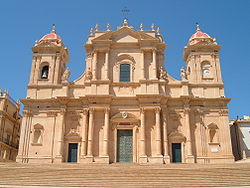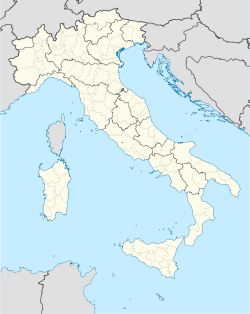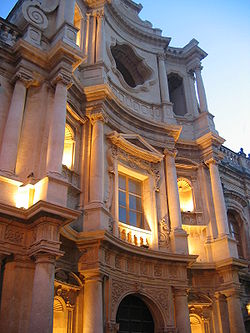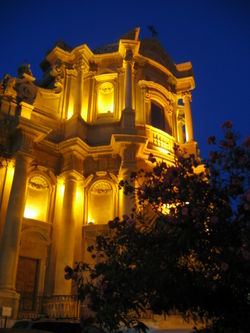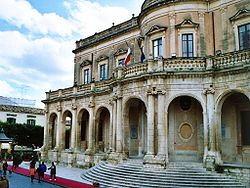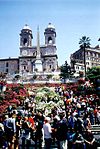- Noto
-
For other uses, see Noto (disambiguation).
Noto — Comune — Città di Noto Cathedral of Noto 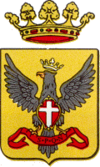
Coat of armsLocation of Noto in Italy Coordinates: 36°53′N 15°05′E / 36.883°N 15.083°E Country Italy Region Sicily Province Syracuse (SR) Frazioni see list Government – Mayor Corrado Valvo Area – Total 550.86 km2 (212.7 sq mi) Elevation 152 m (499 ft) Population (30 April 2009) – Total 23,816 – Density 43.2/km2 (112/sq mi) Demonym Notinesi or Netini Time zone CET (UTC+1) – Summer (DST) CEST (UTC+2) Postal code 96017 Dialing code 0931 Patron saint San Corrado Confalonieri Saint day February 19 Website Official website Noto (Sicilian: Notu, Latin: Neetum and Netum) is a city and comune in the Province of Syracuse, Sicily (Italy). Its located 32 km southwest of the city of Syracuse at the foot of the Iblean Mountains and gives its name to the surrounding valley, Val di Noto. In 2002 Noto and its church were declared a UNESCO World Heritage Site.[2]
Contents
History
Main article: NetumThe older town, Noto Antica, lies 8 km directly north on Mount Alveria. It was ancient Netum, a city of Sicel origin, left to Hiero II by the Romans by the treaty of 263 BCE and mentioned by Cicero as a foederala citilas (Verr. v. 51, 133), and by Pliny as Latinae conditionis (Hist. Nat. iii. 8. 14). According to legend, Dedalus stopped here after his flight over the Ionian Sea, as well as Hercules, after his seventh task.
In the Roman era, it opposed praetor Verres. In 866 it was conquered by the Arabs, who elevated to a capital city of one of three districts of the island (the Val di Noto). Later it was a rich Norman city.
In the 16th and 17th centuries, the city brought forth several notable intellectual figures, including Giovanni Aurispa, jurists Andrea Barbazio and Antonio Corsetto, as well as the architect Matteo Carnelivari and the minor composer Mario Capuana. In 1503 king Ferdinand III gave it the title of civitas ingeniosa ("ingenious city"). In the following centuries, the city expanded enlarging its medieval limits; and new buildings, churches and convents were built. These, however, were all totally destroyed by the 1693 earthquake. The devastation of the city on Mount Alveria was accompanied by its economy[clarification needed], which relied mainly on agricultural products– vine, oil, cereals, rice, cotton– and its renowned handicrafts.
The current town, rebuilt after the earthquake on the left bank of River Asinaro, was planned on a grid system by Giovanni Battista Landolina. This new city occupied a position nearer to the Ionian Sea. The presence of architects like Rosario Gagliardi, Francesco Sortino and others, made the new Noto a masterpiece of Sicilian Baroque, dubbed the "Stone Garden" by Cesare Brandi and is currently listed among UNESCO's World Heritage Sites. The new structures are characterized by a soft tufa stone, which under sunlight assumes a typical honey tonality. Parts of the cathedral suddenly collapsed in 1996, a great loss to Sicilian Baroque.
The city, which had lost its provincial capital status in 1817, rebelled against the House of Bourbon on May 16, 1860, leaving its gates open to Giuseppe Garibaldi and his expedition. Five months later, on October 21, a plebiscite sealed the annexation of Noto to Piedmont.
In 1844, Noto was named a bishopric seat, but in 1866 suffered the abolition of the religious guilds, which were deeply linked to the city's structures and buildings.
Noto was freed from fascist dictatorship in July 1943. At the referendum of 1946, the Notinesi people voted in favour of the monarchy.
Main sights
Noto is famous for its fine buildings of the early 18th century, considered among the main masterpieces in the Sicilian baroque style. It is a place of many religious buildings, there are several palaces, and many others. The old has mixed with the new, and a view from the top of a building on the hill will show the older buildings mixed with new and rebuilt architecture.
Palaces and other buildings
- Ducezio Palace, the current Town Hall. Designed by Vincenzo Sinatra, it houses neo-classical style frescoes by Antonio Mazza.
- Astuto Palace.
- Villadorata palace on Via Nicolaci which was built by P. Labisi in 1733.
Religious buildings
- Cathedral of San Nicolò di Mira (finished 1776).
- Church of Santa Caterina.
- Church of San Corrado.
- Church of the Collegio di San Carlo.
- Church of the Sacro Nome di Gesu.
- Monastery of Santa Chiara (1735), designed by Gagliardi. It has an oval plant, the interior divided by twelve columns housing a Madonna with Child from the 16th century.
- Church of San Michele Arcangelo.
- Church of Santa Maria della Scala.
- Church of Santissimo Salvatore.
- Town Library.
- Church of San Nicola di Mira.
- Church of Santa Chiara, with a precious Madonna by Antonello Gagini.
- Church of San Francesco d'Assisi (Immacolata).
- Church of the Spirito Santo.
- Church of Ecce Homo.
- Church of Santa Maria dell'Arco.
- Church of the Anime Sante del Purgatorio ("Holy Souls of the Purgatory").
- Church of Santa Maria della Rotonda.
- Church of the Santissima Trinità.
- Church of San Carlo al Corso (by Rosario Gagliardi).
- Church of Santa Maria del Carmelo.
- Church of San Pietro Martire.
- Church of San Michele Arcangelo.
- Church of San Domenico (by Rosario Gagliardi).
- Church of Sant'Antonio Abate.
- Church of Santa Caterina.
- Church of the Crociferio di San Camillo.
- Church of Montevergine (San Girolamo).
- Church of Santissimo Salvatore.
- Church of San Andrea Apostolo.
- Church of San Pietro delle Rose (Saints Peter and Paul).
- Church of the SS. Crocifisso.
- Church of Sant'Egidio Vescovo.
- Church of Santa Maria del Gesù.
- Church of Annunziata.
- Church of Santa Agata.
Archaeological finds
The remains of Noto's early inhabitants are almost entirely hidden beneath the ruins of the mediaeval town, except for three chambers cut into the rock. One is noted by an inscription in the library at Noto to have belonged to the gymnasium, while the other two were heroa (shrines of heroes). But explorations have brought to light four cemeteries of the third Sicel period, and one of the Greek period, of the 3rd and 2nd centuries BC. There are also catacombs of the Christian period and some Byzantine tombs.
Four miles to the south of Noto, on the left bank of the Tellaro (Helorus) stands a stone column about 10 metres high, which is believed to be a memorial of the surrender of Nicias. In the 3rd century BC, a tomb was excavated in the rectangular area which surrounds it, destroying apparently a pre-existing tomb. The later burial belongs to the necropolis of the small town of Heloron, 750 m to the southeast, some remains of which have been discovered. It was a small advanced post of Syracuse, belonging probably to the 6th century BC.
Culture
For other uses, see Late Baroque Towns of the Val di Noto (South-Eastern Sicily).Late Baroque Towns of the Val di Noto (South-Eastern Sicily) * UNESCO World Heritage SiteCountry Italy Type Cultural Criteria i, ii, iv, v Reference 398 Region ** Europe and North America Inscription history Inscription 2002 (20th Session) * Name as inscribed on World Heritage List
** Region as classified by UNESCOIn the Noto neighbourhood, a 32-m radiotelescope was installed by the Istituto di Radioastronomia di Bologna as part of the Consiglio Nazionale delle Ricerche. It works in collaboration with a similar instrument in Medicina, Bologna.
The city has held an annual flower festival, the Infiorata,[3] every May since the 1980s, lining the streets with floral works of art.
Frazioni
Baulì, Buonivini (it means "good wines"), Calabernardo, Castelluccio, Cipolla, Coda di Lupo, Falconara, Fondo Morte, Lenzavacche, Lido di Noto, Madonna Marina, Pantano Longarini, Pietà San Giovannello, Reitani, Rigolizia, San Corrado di Fuori, San Lorenzo, San Marco, San Paolo, Santa Lucia, Serra di Vento, Testa dell'Acqua, Vendicari, Villa Vela.
Economy
In this territory there are many wine producers, not big in terms of quantity but great in terms of quality.
Fotogallery
See also
References
- Sicily and Its Islands, 2004 - Ugo La Rosa editore
- ^ From John J. Ide, Noto - the Perfect Baroque City, Journal of the Royal Institute of British Architects, no. 66, 1958, p. 15
- ^ Late Baroque Towns of the Val di Noto - listing on UNESCO website
- ^ L'INFIORATA di NOTO( Noto's Flower Festival )NOTO on-line: City of Noto, Unesco World Heritage Site
External links
Categories:- Cities and towns in Sicily
- Municipalities of the Province of Syracuse
- Sicilian Baroque
- Wine regions of Italy
- World Heritage Sites in Italy
Wikimedia Foundation. 2010.

